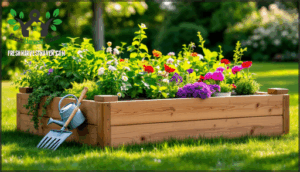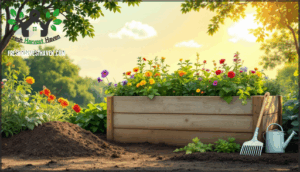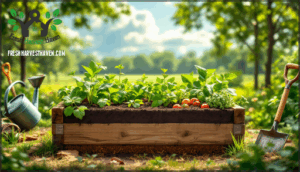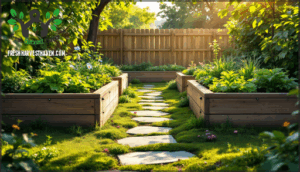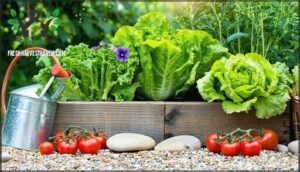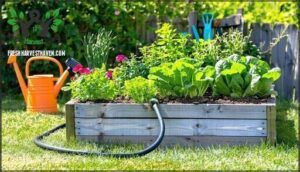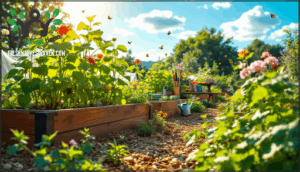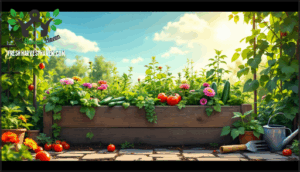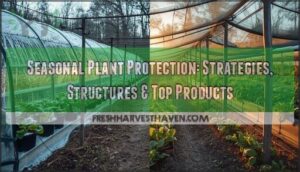This site is supported by our readers. We may earn a commission, at no cost to you, if you purchase through links.
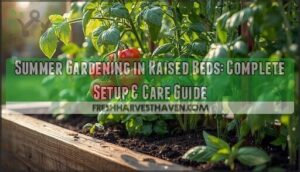
The difference wasn’t luck or expensive equipment. Raised beds naturally solve summer’s toughest challenges: heat stress, water waste, and pest pressure. When you build and manage them correctly, they transform summer gardening from a daily chore into a productive system that practically runs itself.
The secret lies in getting the fundamentals right from the start—choosing materials that won’t leach or rot, engineering soil that drains fast but holds moisture where roots need it, and setting up irrigation that delivers water efficiently during the hottest months.
Table Of Contents
- Key Takeaways
- Preparing Raised Beds for Summer Success
- Selecting Summer Crops for Raised Beds
- Watering and Mulching Strategies
- Managing Heat, Pests, and Disease
- Ongoing Raised Bed Maintenance
- Frequently Asked Questions (FAQs)
- What to plant in a raised garden bed in summer?
- What vegetables should not be grown in a raised bed?
- How often should raised bed soil be replaced?
- Can winter crops grow in summer raised beds?
- Whats the ideal raised bed depth for vegetables?
- Should raised beds face north or south?
- How to protect plants from extreme summer storms?
- Can raised beds be used year-round?
- Whats the ideal raised bed depth?
- How do I winterize my beds?
- Conclusion
Key Takeaways
- Raised beds solve summer’s core challenges—heat stress, water waste, and pest pressure—through smart material choices, engineered soil that drains fast but holds moisture at root level, and efficient irrigation that delivers water during peak heat without constant intervention.
- Success hinges on three foundational decisions: selecting rot-resistant materials like cedar or copper-treated lumber, building beds 18-24 inches tall for accessibility and pest control, and filling them with layered organic matter that balances drainage with moisture retention.
- Drip irrigation paired with 2-3 inches of organic mulch cuts water use by 50-70% while maintaining consistent soil moisture, eliminating the daily watering routine that turns traditional gardens into time-consuming chores.
- Heat-tolerant crops like tomatoes, peppers, and okra thrive in raised beds when supported by companion planting strategies (tomato-basil pairings boost yields 20%, onions beside carrots slash pest damage 60%) and vertical growing techniques that increase production up to 40%.
Preparing Raised Beds for Summer Success
Getting your raised beds ready for summer starts with smart decisions about materials, dimensions, and soil. You’ll need to think through what you’re building with, how tall to go, and what you’re filling those beds with.
Before you plant a single seed, you’ll also want to map out your layout and decide how you’re getting water to your crops.
Choosing The Best Raised Bed Materials
Your choice of raised bed material sets the foundation for years of gardening success—or frustration, so it’s worth getting right from the start. Wood options like rot-resistant cedar or treated lumber with copper give you solid soil retention without arsenic worries. Metal frames last longer but heat up fast.
For raised bed construction, pair 2x10s with corner brackets and 4x4s—you’ll get the durability and soil control that makes raised bed gardening worthwhile.
Determining Ideal Bed Height and Dimensions
Once you’ve locked in your materials, the next move is figuring out how tall and wide to build—and that decision hinges on your back, your budget, and what you’re growing. Taller raised bed designs cut down on bending and keep weeds and critters at bay, while bed height considerations around 18–24 inches offer solid garden accessibility without breaking the bank.
For width, stick to 3–4 feet max so you can reach the center without stepping in—that’s space optimization and ergonomic design working together for smarter raised bed gardening.
Filling Raised Beds: Soil Mixes and Alternatives
Now that your beds are framed and positioned, it’s time to fill them—and what goes inside matters just as much as what holds it together. A balanced soil composition starts with quality organic matter—compost, aged manure, or peat moss—blended with topsoil for structure.
For bed filling on a budget, layer coarse fill materials like straw or wood chips at the bottom, then top with amended soil for better soil quality and garden bed preparation.
Planning Layout and Irrigation Systems
Before you plant your first seedling, sketch out where everything will go and how you’ll keep it watered—a solid layout now saves you from scrambling mid-season. Here’s your game plan for layout optimization and irrigation design:
- Map bed spacing at 2–3 feet between boxes for comfortable movement and garden bed preparation access
- Plan drip irrigation before planting—running lines to each bed boosts water efficiency and simplifies irrigation options
- Consider soil depth when positioning tall crops versus shallow-rooted varieties for smarter garden design and layout
With your raised bed gardening tips in place, you’re ready to plant with confidence.
Selecting Summer Crops for Raised Beds
Once your raised bed is ready, it’s time to pick the right plants that can tolerate summer’s heat and humidity. Choosing crops that thrive in warm conditions means you’ll get better yields with less frustration.
Let’s look at the vegetables, fruits, flowers, and companion planting combinations that work best when temperatures climb.
Top Vegetables for Summer Raised Beds
Your vegetable selection sets the foundation for your summer raised bed garden success. Tomatoes lead the charge—heat-tolerant types like ‘Arkansas Traveler’ can deliver up to 20 pounds per plant when conditions peak. Peppers thrive in the fast-draining warmth raised beds provide, with ‘California Wonder’ bells producing over 10 fruits per season. Bush beans mature in just 50-60 days, perfect for crop rotation strategies that keep your garden layout productive all summer long. Cucumbers and zucchini round out the essentials, with proper soil preparation enabling multiple pounds of harvest per plant.
For key growth, understanding raised bed benefits is vital for selecting the right vegetables.
| Vegetable | Days to Harvest | Expected Yield |
|---|---|---|
| Tomatoes | 60-85 days | Up to 20 lbs/plant |
| Bell Peppers | 70-80 days | 10+ fruits/plant |
| Bush Beans | 50-60 days | Multiple plantings |
| Zucchini | 45-50 days | Several lbs/plant |
Fruits and Flowers That Thrive in Heat
Fruits bring adaptability to your summer raised bed setup. Strawberries deliver elevated production with less rot, while blueberries benefit from pH control you can fine-tune.
Hot peppers hold strong past 95°F, outpacing tomatoes when heatwaves strike. Okra germinates only above 75°F soil temperatures and thrives beyond 90°F—perfect for vertical gardening strategies.
Zinnias and sunflowers fuel pollinator activity, boosting fruit production across your vegetable garden. Marigolds retain vibrancy in metal beds, supporting sustainable gardening practices. These heat-tolerant plants increase summer blooms and water conservation.
For best growth, consider using heat tolerant veggies in your raised bed setup.
Companion Planting Strategies
Smart pairing transforms raised beds into productivity zones. Companion planting strategies leverage biodiversity enhancement to strengthen pest control, improve soil health, and boost pollination methods naturally.
- Tomato–basil pairings yield 20% more fruit per square foot while cutting aphid problems in half through strategic vegetable gardening techniques
- Onions beside carrots slash carrot fly damage by over 60%, proving essential for sustainable gardening practices and crop rotation planning
- Marigolds around peppers reduce nematode trouble by 50%, acting as living pest control without chemicals
- Sunflowers with cucumbers increase pollination success by 35%, drawing beneficial insects that support multiple raised bed crops
These gardening techniques deliver measurable results while building healthier ecosystems.
Using Tomato Cages and Support Structures
Supporting your tomato plants isn’t just about preventing collapse—it’s about unlocking yields up to 40% higher when vines grow vertically instead of sprawling across the ground. Vertical gardening techniques like crop staking optimize space in raised beds while improving airflow around foliage, cutting disease risk dramatically during humid summer gardening conditions.
Staking tomatoes vertically can boost yields by 40% while reducing disease through better airflow in raised beds
| Support Type | Best For | Setup Difficulty |
|---|---|---|
| Wire tomato cage designs | Determinate varieties | Easy |
| Wooden trellis options | Indeterminate climbers | Moderate |
| String plant support systems | Heavy-fruiting types | Expert |
| Stake-and-weave methods | Row plantings | Moderate |
Choose structures that match your vegetable gardening goals and the space available when gardening in raised beds this season.
Watering and Mulching Strategies
Raised beds drain faster and heat up quicker than in-ground gardens, which means you’ll need a solid watering plan to keep your summer crops thriving.
The right irrigation setup and mulching strategy can cut your water use in half while protecting plants from heat stress.
Here’s how to set up efficient systems that work smarter, not harder.
Efficient Drip Irrigation Setups
Drip irrigation isn’t just a convenience—it’s the difference between constantly babysitting your raised beds and letting them practically water themselves while you sip lemonade in the shade.
Start by laying drip tubing along each row, connecting irrigation lines to a main water supply with appropriate pipe sizing to maintain steady water pressure. Install irrigation timers to automate delivery and monitor soil moisture regularly—this setup represents one of the smartest water conservation methods available, giving you total control while maximizing water conservation in gardening.
Best Times and Techniques for Watering
Timing your watering isn’t rocket science, but getting it wrong can turn your thriving raised bed into a wilted disappointment faster than you’d think. Here’s your watering playbook:
- Water early morning (5-9 AM) when evaporation control is strongest
- Check soil moisture 2-3 inches deep before watering
- Apply 1-1.5 inches weekly through drip irrigation or drip tubing
- Skip overhead evening watering—it invites fungal diseases
- Adjust irrigation options during heatwaves when beds dry twice as fast
Master these water conservation methods and you’ll maintain healthy root zones while slashing water waste.
Mulch Types to Reduce Evaporation
Once you’ve nailed your watering schedule, the right mulch can slash evaporation by up to 70% and keep your raised beds from turning into a desert between irrigation sessions.
Here’s what works:
| Organic Mulch Type | Water Conservation Impact | Garden Maintenance Tips |
|---|---|---|
| Wood Chips | Excellent soil retention, lasts 2-3 years | Apply 2-3 inches thick for best results |
| Bark Mulch | Moderate moisture control, attractive finish | Reapply annually as it breaks down |
| Straw Cover | Outstanding airflow, prevents soil crusting | Use weed-free varieties to avoid extra weeding |
These soil preparation techniques pair perfectly with drip irrigation options—you’ll maintain consistent moisture while your mulch manages the heavy lifting between watering sessions.
Black Plastic Sheeting for Moisture Control
Black plastic sheeting locks moisture in with brutal efficiency, but you’ll need to weigh the water-saving benefits against its impact on soil life and summer heat buildup.
Here’s what you’re signing up for:
- Moisture retention that cuts evaporation control needs by 50–70% during peak summer heat.
- Soil temperature spikes of 8–12°F above ambient, which can stress shallow-rooted crops in raised beds.
- Weed suppression that’s nearly 100% effective when properly anchored around bed perimeters.
- Plastic mulching durability—expect one season of use before UV degradation compromises effectiveness.
- Garden maintenance trade-off: less watering but zero contribution to soil health compared to organic mulches.
Managing Heat, Pests, and Disease
Summer heat brings challenges that can make or break your raised bed garden. The key is staying one step ahead of stress, invaders, and infection before they take hold.
Here’s how to shield your plants and keep them thriving when conditions get tough.
Protecting Plants From Excessive Sun and Heatwaves
When summer temperatures soar past 90°F, even your toughest raised bed crops can wilt under the relentless sun—but you don’t have to watch your garden suffer through the heat. Deploy shade cloth over vulnerable plants during peak afternoon hours to drop temperatures by 10-15°F, or try evaporative cooling with strategic misting.
Sunscreen sprays and soil cooling mulches boost heat tolerance, making your summer gardening tips work overtime while supporting water conservation and sustainable gardening through smart plant care and garden maintenance.
Preventing and Controlling Summer Pests
Heat stress leaves plants vulnerable, but pests can destroy your entire raised bed crop overnight. Colorado potato beetles, flea beetles, and aphids—which hit up to 34% of raised beds—are your primary enemies. You’ll win this bug patrol battle by layering your defenses:
- Install hardware cloth underneath to block 90-95% of burrowing rodents before they reach roots
- Release green lacewings or Trichogramma wasps to knock down aphid and beetle populations by 55-75%
- Apply row covers during peak season to cut flying pest infestations by 70%
- Scout weekly for early detection—catching outbreaks two weeks sooner means stopping damage before it spreads
Integrated management combining barrier techniques, biological controls, and organic gardening methods keeps gardening pests in check without drowning your beds in chemicals.
Reducing Disease Risk With Proper Practices
Proper watering transforms disease prevention into a daily gardening technique—water at the base to slash fungal outbreaks by 25–35% compared to overhead methods. Rotate crops annually to cut soil-borne disease by 60%, and add mulch for soil solarization that drops pathogen loads substantially.
Clean, sterilized soil eliminates 70–90% of pathogen introduction, while minimal disturbance preserves disease-suppressive conditions. These soil and crop management strategies and organic gardening methods protect your raised beds without chemicals.
Ongoing Raised Bed Maintenance
Keeping your raised beds productive through summer means staying on top of a few essential tasks. You’ll need to feed your plants regularly, guide their growth with smart pruning and support, and avoid common pitfalls that can derail even experienced gardeners.
Here’s how to keep everything running smoothly from planting to harvest.
Fertilization and Nutrient Management
Your raised bed’s nutrient reserves don’t last forever—by midsummer, even the best soil mix starts running on empty and your plants will show it. Here’s your fertilizing game plan:
- Start with soil testing to see what’s actually missing instead of guessing
- Apply compost tea weekly to boost microbial management and nutrient cycling
- Use organic fertilizers every 3–4 weeks to maintain soil quality and plant nutrition
- Layer finished compost monthly to support organic gardening methods and long-term soil management
Pruning, Training, and Supporting Plants
Training vining plants vertically opens up precious square footage while keeping fruit clean and easier to harvest. Install sturdy trellises or cages early—before roots spread—and gently weave stems through structures weekly. Prune lower leaves to improve airflow and redirect energy to fruit production.
| Plant Type | Training Method | Pruning Focus |
|---|---|---|
| Tomatoes | Staking, caging | Remove suckers, thin lower leaves |
| Cucumbers | Trellis weaving | Pinch side shoots |
| Squash | Branch propping | Thin crowded foliage |
| Beans | Vertical support | Minimal pruning needed |
These gardening techniques keep your plants productive and your raised bed organized.
Sustainable Practices for Healthy Summer Gardens
Building a thriving garden means working with nature, not against it. So, let’s talk about practices that keep your soil alive, your water use smart, and your beds producing year after year. Compost additions fuel soil conservation, while organic methods keep your vegetable garden chemical-free. Mulching aids water harvesting and climate resilience during heat spikes.
These eco-friendly sustainable gardening habits turn your raised bed into a self-sustaining system—giving you better summer gardening ideas and stronger organic gardening results season after season.
Common Mistakes and How to Avoid Them
Even seasoned gardeners stumble over the same handful of pitfalls—and knowing what they are can save you weeks of frustration and a summer’s worth of crops. Here’s what trips up most raised beds gardening efforts:
- Overwatering without checking bed drainage—soggy soil leads to root binding and nutrient deficiency fast
- Ignoring soil compaction—packed earth chokes roots and blocks water flow
- Skipping mulch during heatwaves—bare soil dries out in hours, stressing your vegetable gardening setup
- Planting too densely—crowded crops compete for nutrients and invite disease in summer gardening conditions
Frequently Asked Questions (FAQs)
What to plant in a raised garden bed in summer?
If you think tomatoes are the only crop worth planting, you’re missing half the summer vegetable gardening party.
Heat tolerant champions like peppers, eggplant, beans, squash, cucumbers, and okra thrive in raised beds alongside seasonal bloom flowers for garden diversity.
What vegetables should not be grown in a raised bed?
Most vegetables thrive in raised beds, but deep-rooted crops like artichokes or large sprawling plants such as pumpkins may struggle with space constraints. Corn often performs poorly due to shallow soil depth affecting stability.
Meanwhile, crop rotation becomes trickier with perennials occupying permanent spots in your vegetable garden.
How often should raised bed soil be replaced?
Most gardeners don’t need full Soil Replacement in raised beds. Instead, focus on annual Bed Refresh by adding Organic Matter and compost. Soil Testing guides Fertilizer Management decisions.
With proper soil preparation and garden maintenance and care, your soil quality improves over time through consistent soil management in raised beds.
Can winter crops grow in summer raised beds?
Most winter crops struggle in summer’s heat, but a few exceptions exist. Kale and Swiss chard tolerate warm soil with afternoon shade.
For true seasonal crop rotation, wait until late summer to plant winter varieties when soil temperature management becomes easier.
Whats the ideal raised bed depth for vegetables?
Most vegetables need 6-12 inches of soil depth for healthy root growth. Shallow-rooted crops like lettuce thrive in 6-8 inches, while tomatoes and peppers perform best with 12 inches or more in your raised bed gardening setup.
Should raised beds face north or south?
Orientation matters, but it’s not as simple as picking north or south. For most vegetable gardens, an east-west orientation works best—your plants capture morning light on one side and afternoon sun on the other, preventing taller crops from shading shorter ones throughout the day.
How to protect plants from extreme summer storms?
Secure tall plants with stakes before storms hit, and use row covers or cloches for smaller crops.
Improve drainage around beds and anchor lightweight containers to prevent wind damage and flooding.
Can raised beds be used year-round?
Absolutely, raised beds excel at Year Round Crops with smart adjustments. Winter Gardening thrives using Cold Frame Use and Bed Insulation.
Season-extend your vegetable garden through Seasonal Planting techniques—sustainable gardening doesn’t pause when temperatures drop.
Whats the ideal raised bed depth?
Raised bed depth usually ranges from 6 to 12 inches for most vegetables, though 8 to 10 inches supplies ideal root zone space and soil volume without excessive bed construction costs or accessibility challenges.
How do I winterize my beds?
As frost approaches, remove spent plants and add a thick compost layer for soil protection. Cover beds with mulch or tarps for freeze prevention.
Consider installing a cold frame for fall planting guide opportunities and garden maintenance through winter.
Conclusion
You’ve built the foundation—sturdy beds, balanced soil, efficient irrigation. You’ve chosen crops that thrive under pressure and set up systems that work with summer’s intensity instead of fighting it.
Now summer gardening in raised beds becomes what it should be: a reliable producer, not a daily crisis. Your neighbor will still be dragging hoses while you’re harvesting consistently.
The difference isn’t magic—it’s method. And you’ve mastered it.

